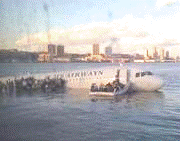Bird Strike Committee Proceedings

Bird Strike Committee-USA/Canada Joint Annual Meeting: 10th (2008)
Date of this Version
8-2008
Document Type
Article
Abstract
Similar to many populations of large North American bird species, wild turkey populations have rebounded largely due to conservation efforts. Historically, reports of turkey – aircraft strikes are infrequent; however, in the last five years reported turkey/ aircraft strikes have risen by 47%. FAA National Wildlife Strike Database figures indicate 36 aircraft-turkey collisions in the past 16 years (1991 to 2006). Airport managers are seeking solutions to mitigate the threat to aviation safety that turkeys pose. Turkeys have become a highly sought game bird and the use of depredation to mitigate turkey problems at airports; while legal, could be viewed negatively by some sectors of the public. An alternative is to integrate a trap/relocation program into the airport wildlife hazard management plan. Prior to 1991, Marine Corps Air Station Cherry Point located in the coastal plain of North Carolina had one reported wild turkey on the installation. A re-stocking program took place in 1991 and 1992 with a total of 15 bird released. Excellent habitat and closed hunting seasons resulted in a thriving population. Over time, localized flocks were observed traversing the airfield while foraging in the open grasslands adjacent to runways causing a potential threat to aviation. Following the decision to re-locate turkeys a total of 61 birds were captured from 1994 through 2007 using a rocket net set-up. Of the 61 birds caught, 55 were transported from the air station and released at other military installations or public lands within the state of North Carolina. Our plans are to continue to monitor the turkey population and expand this program in future years to reduce the risk posed by turkeys on the airfield while enhancing the opportunity for hunting in appropriate off-airfield areas.


Comments
Abstract of paper presented at Bird Strike Committee USA/Canada Meeting, Lake Mary and Sanford, Florida, August 18–21, 2008.